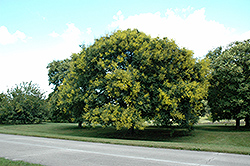It's all about ...
plants

September Golden Rain Tree
Koelreuteria paniculata 'September'
Height: 40 feet
Spread: 40 feet
Sunlight:
![]()
Hardiness Zone: 6a
Other Names: Varnish Tree, Pride of India
Description:
An exceptional small ornamental tree with airy panicles of golden yellow flowers in mid summer, followed by papery brown, lantern-shaped fruit, and beautiful yellow fall color; very adaptable but flowers best in full sun
Ornamental Features
September Golden Rain Tree features airy plumes of yellow flowers rising above the foliage in mid summer. It features abundant showy brown capsules from early to mid fall. It has emerald green deciduous foliage which emerges burgundy in spring. The serrated pinnately compound leaves turn an outstanding yellow in the fall. The furrowed silver bark adds an interesting dimension to the landscape.
Landscape Attributes
September Golden Rain Tree is a dense deciduous tree with a more or less rounded form. Its average texture blends into the landscape, but can be balanced by one or two finer or coarser trees or shrubs for an effective composition.
This tree will require occasional maintenance and upkeep, and is best pruned in late winter once the threat of extreme cold has passed. Gardeners should be aware of the following characteristic(s) that may warrant special consideration;
- Messy
September Golden Rain Tree is recommended for the following landscape applications;
- Accent
- Shade
Planting & Growing
September Golden Rain Tree will grow to be about 40 feet tall at maturity, with a spread of 40 feet. It has a low canopy with a typical clearance of 4 feet from the ground, and should not be planted underneath power lines. It grows at a medium rate, and under ideal conditions can be expected to live for 60 years or more.
This tree should only be grown in full sunlight. It is very adaptable to both dry and moist locations, and should do just fine under average home landscape conditions. It is considered to be drought-tolerant, and thus makes an ideal choice for xeriscaping or the moisture-conserving landscape. It is not particular as to soil type or pH, and is able to handle environmental salt. It is highly tolerant of urban pollution and will even thrive in inner city environments. This is a selected variety of a species not originally from North America, and parts of it are known to be toxic to humans and animals, so care should be exercised in planting it around children and pets.
This plant is not reliably hardy in our region, and certain restrictions may apply; contact the store for more information.


